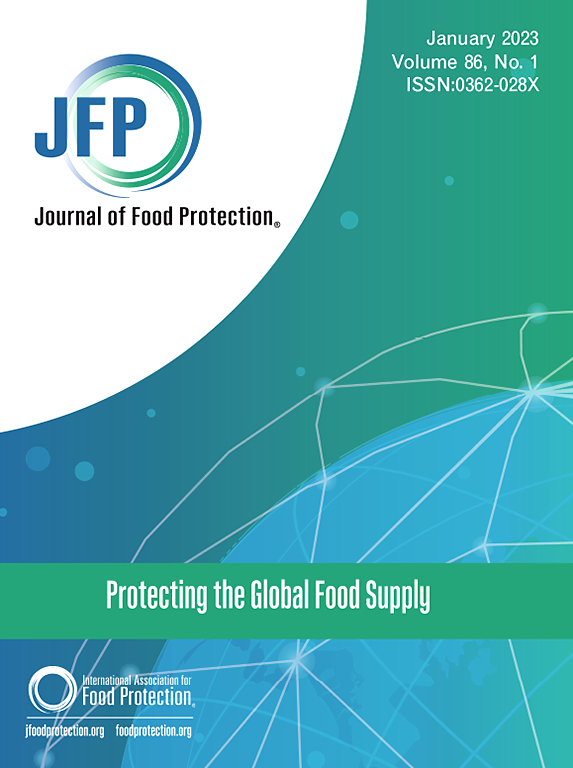Recovered Bacteria Associated with Gas Accumulation in Vacuum-Packaged Fresh Kosher Ground Beef Stored at Refrigeration Temperature
IF 2.1
4区 农林科学
Q3 BIOTECHNOLOGY & APPLIED MICROBIOLOGY
引用次数: 0
Abstract
Vacuum packaging and storage at chilled temperatures are commonly used to prolong the shelf life of meat. Under these conditions, cold-tolerant facultatively anaerobic spoilage microorganisms not only can grow but the conditions are more favorable for their growth because these conditions eliminate competition from cold-tolerant aerobic microorganisms. The objective of this study was to identify bacteria that caused gas formation and accumulation in vacuum-packaged refrigerated fresh kosher ground beef as well as from processing plant environment samples. A total of 87 vacuum-packaged ground beef (∼454 g size) and 33 environmental samples were received from a kosher processing plant. The initial populations of aerobic bacteria (AB), psychrotrophic bacteria (PSYB), Enterobacteriaceae (EB) increased by 0.58–1.09 log CFU/g, while the population of lactic acid (LAB) increased 3.18 log CFU/g after 5d at 2–4 °C. After 5 d storage at 2–4 °C, 34% of the packages exhibited gas accumulation. The accumulated gas reacted with lead acetate and formed a brown-black color indicating hydrogen sulfide (H2S) formation, and the ground beef had a slight off-odor. Lactococcus lactis, Enterobacter cloacae, and Klebsiella oxytoca were the most isolated from environmental samples. Based on the results from the present study, the potential bacteria responsible for gas accumulation and distention of the vacuum-packaged ground beef were Leuconostoc mesenteroides (LAB), Lactobacillus curvatus (LAB), and Serratia liquefaciens (EB). The bacterial strains isolated from 5 d storage distended packages after 5 d storage were dominantly LAB, while the bacterial strains isolated after 56 d storage were mainly EB. These results indicated that LAB are potentially responsible for gas formation that occurs early postpackaging.
在冷藏温度下真空包装的新鲜洁食碎牛肉中与气体积累相关的回收细菌。
真空包装和冷藏通常用于延长肉类的保质期。在这些条件下,耐寒兼性厌氧腐败微生物不仅可以生长,而且条件更有利于它们的生长,因为这些条件消除了来自耐寒好氧微生物的竞争。本研究的目的是鉴定真空包装冷藏新鲜洁食碎牛肉以及加工厂环境样品中引起气体形成和积聚的细菌。从kosher加工厂接收了87份真空包装的碎牛肉(约454克大小)和33份环境样品。在2-4℃条件下培养5d后,好氧菌(AB)、心营养菌(PSYB)、肠杆菌科(EB)的初始数量增加了0.58 ~ 1.09 log CFU/g,乳酸菌(LAB)的初始数量增加了3.18 log CFU/g。在2-4°C下储存5 d后,34%的包装出现了气体积聚。积聚的气体与醋酸铅发生反应,形成棕黑色,表明硫化氢(H2S)形成,碎牛肉有轻微的异味。乳酸乳球菌、阴沟肠杆菌和产氧克雷伯菌是环境样品中分离最多的。根据本研究结果,真空包装碎牛肉的气体积聚和膨胀的潜在细菌是肠系膜芽孢杆菌(leconostoc mesenteroides, LAB)、弯曲乳杆菌(Lactobacillus curvatus, LAB)和液化沙雷菌(Serratia液化)。贮藏5 d后从膨胀包装中分离的菌株以LAB为主,贮藏56 d后分离的菌株以EB为主。这些结果表明,LAB是潜在的负责气体形成,发生在早期包装后。
本文章由计算机程序翻译,如有差异,请以英文原文为准。
求助全文
约1分钟内获得全文
求助全文
来源期刊

Journal of food protection
工程技术-生物工程与应用微生物
CiteScore
4.20
自引率
5.00%
发文量
296
审稿时长
2.5 months
期刊介绍:
The Journal of Food Protection® (JFP) is an international, monthly scientific journal in the English language published by the International Association for Food Protection (IAFP). JFP publishes research and review articles on all aspects of food protection and safety. Major emphases of JFP are placed on studies dealing with:
Tracking, detecting (including traditional, molecular, and real-time), inactivating, and controlling food-related hazards, including microorganisms (including antibiotic resistance), microbial (mycotoxins, seafood toxins) and non-microbial toxins (heavy metals, pesticides, veterinary drug residues, migrants from food packaging, and processing contaminants), allergens and pests (insects, rodents) in human food, pet food and animal feed throughout the food chain;
Microbiological food quality and traditional/novel methods to assay microbiological food quality;
Prevention of food-related hazards and food spoilage through food preservatives and thermal/non-thermal processes, including process validation;
Food fermentations and food-related probiotics;
Safe food handling practices during pre-harvest, harvest, post-harvest, distribution and consumption, including food safety education for retailers, foodservice, and consumers;
Risk assessments for food-related hazards;
Economic impact of food-related hazards, foodborne illness, food loss, food spoilage, and adulterated foods;
Food fraud, food authentication, food defense, and foodborne disease outbreak investigations.
 求助内容:
求助内容: 应助结果提醒方式:
应助结果提醒方式:


